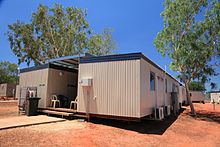Curtin Immigration Reception and Processing Center
The Curtin Immigration Detention Center , also Curtin Detention Center called (German: Immigration Detention Center ), is an Australian detention center for the so-called boat people , the small town 40 kilometers southeast Derby in the arid Kimberley in Western Australia is located. It is located on the grounds of the Curtin Air Force Base operated by the Royal Australian Air Force . The warehouse is run by the private British service company Serco .
history
The policy of mandatory detention , called ( immigration detention in Australia ) , going to the Migration Amendment Act 1992 return, an immigration law that the Labor government of Prime Minister Paul Keating enacted. This law was enacted when, from 1992 onwards, numerous Indonesian boat people tried to reach the coast of Australia in order to apply for asylum there. In 1994 the number of asylum seekers fell. They rose again from 1999 to 2001, when around 9,500 asylum seekers, mostly from the Middle East , came to Australia by boat.
Based on these numbers, the National Liberal government under John Howard reactivated existing internment camps and reopened the Curtin Detention Center in 1999. In 2001, violent unrest and arson broke out in this internment camp. When an investigation in several camps in 2001 found that the Curtin Detention Center had also suffered considerable psychological problems, self-harm, and sexual and violent assaults by unaccompanied children. When around a third of the 340 asylum seekers protested and went on hunger strikes in April 2002, numerous camp employees were injured and there was considerable property damage. Then decreed Chris Evans , the then Minister for Immigration, the closure of this camp.
In June 2010 this internment camp was resumed, and now as a so-called “high security center” for asylum seekers. This happened during the reign of Prime Minister Kevin Rudd of the Labor Party. However, no children should be accommodated, only male asylum seekers. At the time of opening, the storage capacity was enough for 600 people, in November 2010 for 900 people. In December 2010 the capacity reached the limit of 1200 people. The maximum number of people that can be occupied for this camp is 1500. This change of course, made by the Australian Labor Party, has been criticized by numerous commentators as a departure from its immigration policy.
Phillip Ruddock , who was minister responsible for immigration in the national liberal government of John Howard from 1996 to 2003 , described the Curtin Detention Center as the “most primitive” internment camp in Australia.
Storage conditions since 2011
In May 2011 there were 6,729 asylum seekers in Australia, 6,165 of whom were in internment camps. There were 1,433 men in the Curtin camp, 3/4 of these men were in the camp for more than 6 months and 1/3 of them for more than 1 year. 16 men, all from Sri Lanka , had been in the camp for more than 14 months. At that time, the camp had a capacity of 1200 people, the maximum was 1500. When the bedrooms are occupied, 40 men share a room.
The external communication options for asylum seekers are severely limited. Only one line is available for outgoing calls and the use of cell phones is prohibited in the warehouse. Only 18 personal computers are available for Internet access. Faxes can be received, but they must be handed over to a warehouse employee in order to be sent.
The dissatisfaction with the lengthy processing of asylum applications and the resulting stay in the camp, which also severely restricts the external connection with authorities, families and other agencies, led to lasting problems in the camp.
There were 700 recorded cases of self-harm from July 1, 2010 to June 2011, of which 46 were serious. When the Australian Human Rights Commission visited the camp in May 2011, there were 386 people in the camp who had harmed themselves. Five asylum seekers had committed suicide during the above period .
- Life in the Camp (2012)
The leisure and employment opportunities are few in the camp, camp inmates reported that they had never been outside the camp after a year in the camp. Since the beginning of May 2013, under the government of Julia Gillard (Labor Party) , the camp was no longer occupied only with men, but also with families and children. This is still the case today (March 2017) through the subsequent National Liberal governments of Tony Abbott and Malcolm Turnbull .
See also
Web links
Individual evidence
- ↑ Janet Phillips, Harriet Spinks: Immigration detention in Australia , March 20, 2013, at aph.gov.au. Retrieved March 9, 2017
- ↑ Australia immigrants riot in camp , April 5, 2001 on BBC. Retrieved March 9, 2017
- ↑ a b c d e f 2011 Immigration detention at Curtin , from 2011, on Australian Human Rights Commission. Retrieved March 8, 2017
- ↑ Detention center a 'living hell hole' , May 8, 2010, on The Age . Retrieved March 9, 2017
- ↑ Mixed reaction to reopening of Curtin detention center , April 2010, to Australian Broadcasting. Retrieved March 9, 2017
- ↑ Glossary , o.A., on dententionlogs.com.au. Retrieved March 9, 2017
Coordinates: 17 ° 36 ′ 18 ″ S , 123 ° 49 ′ 15 ″ E





